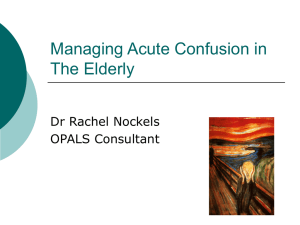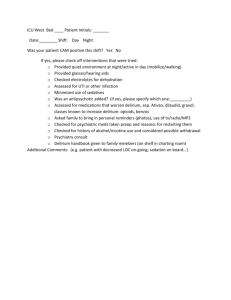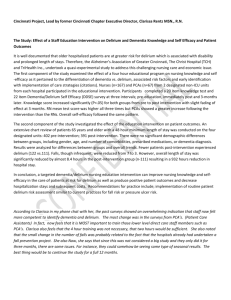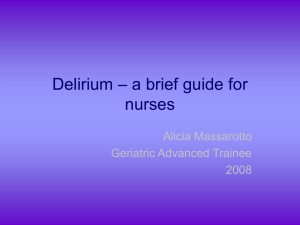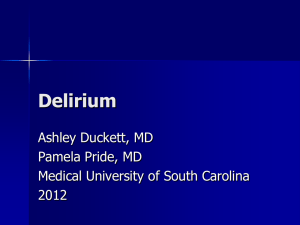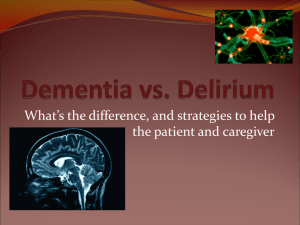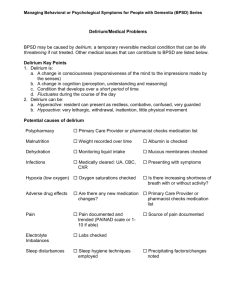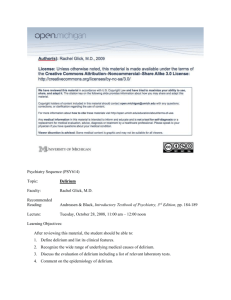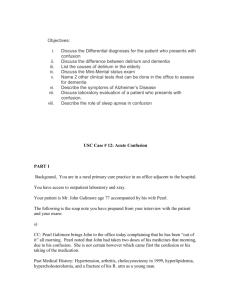Confusion in Older Adults: Determining the Difference Between
advertisement
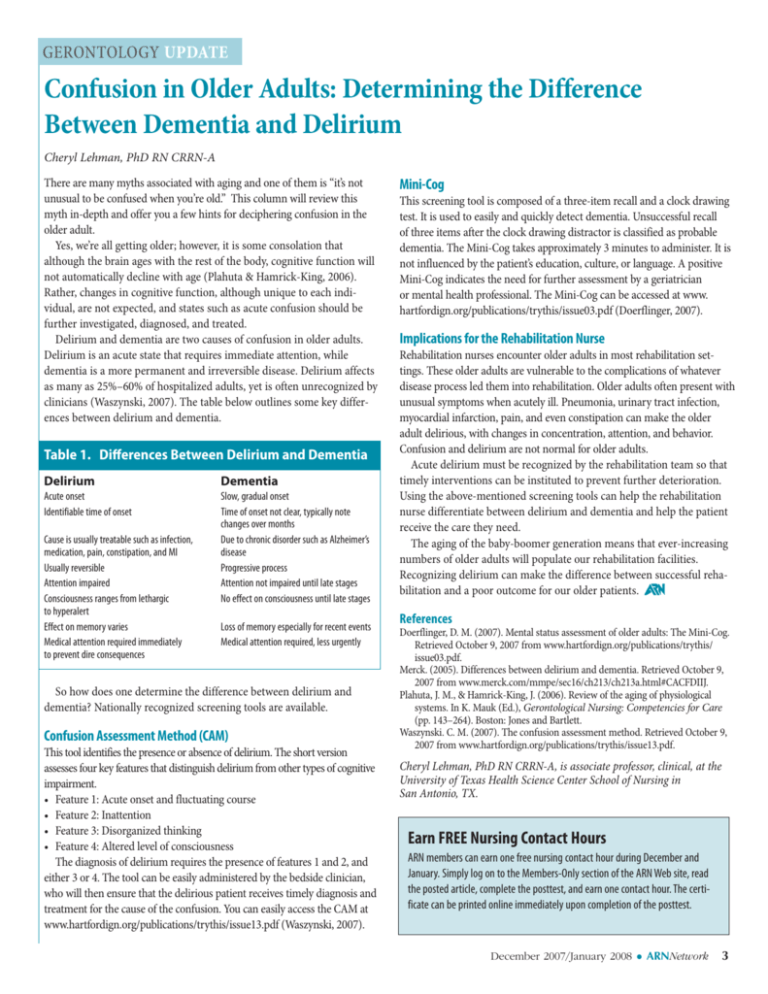
GERONTOLOGY UPDATE Confusion in Older Adults: Determining the Difference Between Dementia and Delirium Cheryl Lehman, PhD RN CRRN-A There are many myths associated with aging and one of them is “it’s not unusual to be confused when you’re old.” This column will review this myth in-depth and offer you a few hints for deciphering confusion in the older adult. Yes, we’re all getting older; however, it is some consolation that although the brain ages with the rest of the body, cognitive function will not automatically decline with age (Plahuta & Hamrick-King, 2006). Rather, changes in cognitive function, although unique to each individual, are not expected, and states such as acute confusion should be further investigated, diagnosed, and treated. Delirium and dementia are two causes of confusion in older adults. Delirium is an acute state that requires immediate attention, while dementia is a more permanent and irreversible disease. Delirium affects as many as 25%–60% of hospitalized adults, yet is often unrecognized by clinicians (Waszynski, 2007). The table below outlines some key differences between delirium and dementia. Table 1. Differences Between Delirium and Dementia Delirium Dementia Acute onset Identifiable time of onset Slow, gradual onset Time of onset not clear, typically note changes over months Due to chronic disorder such as Alzheimer’s disease Progressive process Attention not impaired until late stages No effect on consciousness until late stages Cause is usually treatable such as infection, medication, pain, constipation, and MI Usually reversible Attention impaired Consciousness ranges from lethargic to hyperalert Effect on memory varies Medical attention required immediately to prevent dire consequences Loss of memory especially for recent events Medical attention required, less urgently So how does one determine the difference between delirium and dementia? Nationally recognized screening tools are available. Confusion Assessment Method (CAM) This tool identifies the presence or absence of delirium. The short version assesses four key features that distinguish delirium from other types of cognitive impairment. • Feature 1: Acute onset and fluctuating course • Feature 2: Inattention • Feature 3: Disorganized thinking • Feature 4: Altered level of consciousness The diagnosis of delirium requires the presence of features 1 and 2, and either 3 or 4. The tool can be easily administered by the bedside clinician, who will then ensure that the delirious patient receives timely diagnosis and treatment for the cause of the confusion. You can easily access the CAM at www.hartfordign.org/publications/trythis/issue13.pdf (Waszynski, 2007). Mini-Cog This screening tool is composed of a three-item recall and a clock drawing test. It is used to easily and quickly detect dementia. Unsuccessful recall of three items after the clock drawing distractor is classified as probable dementia. The Mini-Cog takes approximately 3 minutes to administer. It is not influenced by the patient’s education, culture, or language. A positive Mini-Cog indicates the need for further assessment by a geriatrician or mental health professional. The Mini-Cog can be accessed at www. hartfordign.org/publications/trythis/issue03.pdf (Doerflinger, 2007). Implications for the Rehabilitation Nurse Rehabilitation nurses encounter older adults in most rehabilitation settings. These older adults are vulnerable to the complications of whatever disease process led them into rehabilitation. Older adults often present with unusual symptoms when acutely ill. Pneumonia, urinary tract infection, myocardial infarction, pain, and even constipation can make the older adult delirious, with changes in concentration, attention, and behavior. Confusion and delirium are not normal for older adults. Acute delirium must be recognized by the rehabilitation team so that timely interventions can be instituted to prevent further deterioration. Using the above-mentioned screening tools can help the rehabilitation nurse differentiate between delirium and dementia and help the patient receive the care they need. The aging of the baby-boomer generation means that ever-increasing numbers of older adults will populate our rehabilitation facilities. Recognizing delirium can make the difference between successful rehabilitation and a poor outcome for our older patients. References Doerflinger, D. M. (2007). Mental status assessment of older adults: The Mini-Cog. Retrieved October 9, 2007 from www.hartfordign.org/publications/trythis/ issue03.pdf. Merck. (2005). Differences between delirium and dementia. Retrieved October 9, 2007 from www.merck.com/mmpe/sec16/ch213/ch213a.html#CACFDIIJ. Plahuta, J. M., & Hamrick-King, J. (2006). Review of the aging of physiological systems. In K. Mauk (Ed.), Gerontological Nursing: Competencies for Care (pp. 143–264). Boston: Jones and Bartlett. Waszynski. C. M. (2007). The confusion assessment method. Retrieved October 9, 2007 from www.hartfordign.org/publications/trythis/issue13.pdf. Cheryl Lehman, PhD RN CRRN-A, is associate professor, clinical, at the University of Texas Health Science Center School of Nursing in San Antonio, TX. Earn FREE Nursing Contact Hours ARN members can earn one free nursing contact hour during December and January. Simply log on to the Members-Only section of the ARN Web site, read the posted article, complete the posttest, and earn one contact hour. The certificate can be printed online immediately upon completion of the posttest. December 2007/January 2008 • ARNNetwork 3
